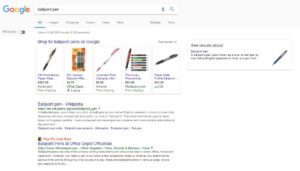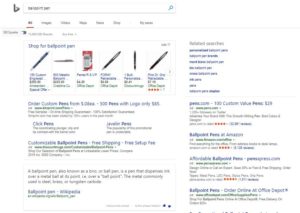The Web Search and the SERP
We are all guilty of opening up a web browser and typing in some phrase to a search engine, and assuming it will read our mind and deliver to us what we are looking for on the search engine results page or SERP. Miraculously, what we are looking for usually shows up somewhere within the plethora of information that is displayed after we hit enter. Do we ever stop and take a look at what actually shows up after we type something into Google or Bing? The Bing search results and the Google search results are usually similar, but each is unique in their structure of search page layouts. Searches are constantly changing and the results users want are also constantly changing.
The SERP


Above we see two different search engine results pages, one from Google on the left, and the other from Bing on the right. The phrase “ballpoint pen” was typed into the search query box and subsequently returned a bunch of different links, images, and ads that we can click on. Notice what is the same and what is different about each page.
The search engine results page or SERP has a layout that includes many several different aspects. Right below the search query box, there is what is called horizontal navigation buttons. These buttons limit your search to more specified subsets like videos, news, photos, shopping, or maps. Depending on the search, the SERP layout might also include vertical navigation buttons, in the ballpoint pen search on Bing, it displays some related searches that we might also be interested in based on our original query. After the search has been executed, there appears a couple links alongside the search query box. First is the results information link. This shows how many pages the search returned and how fast it was etc. Also there is a link for advanced search options. If the query doesn’t return many results, there may be query refinement suggestion links near the box as well, in order to clarify the search.
Moving down on the SERP, usually some PPC or paid search advertising is displayed. These are usually displayed near the top of the page, as companies are paying for them to be near the top, in order to increase the likelihood that they are clicked on. Platforms like Google AdWords and Microsoft adCenter produce and place these types of advertisements and there are a number of factors that influence their placement position. Many of these will have a small piece of text indicating they are a paid ad. Below the paid search advertising, are usually some sort of shopping results, linking users to different vendors which may be selling whatever was searched. Our example of the ballpoint pen gives links to Office Depot and Penfactory.com.
After seeing everything discussed thus far, we scroll down on the SERP to the section in which the organic results are found. Google is constantly crawling and indexing the sites on the internet. Natural results are sites that are deemed popular, relevant, and legitimate according to the complicated algorithms created by Google.
In Conclusion
We all depend on the web search a lot more that we probably realize. Whether it’s to check some sports scores or find a journal for a research paper, we are always using it. Knowing what all the different sections are can help to quickly navigate to the information source we are looking for, like shopping, images, or news. Each portion of the search engine results page has a purpose and we can use that to our advantage, if we know what it does and how to implement it.
Austin Phelps
